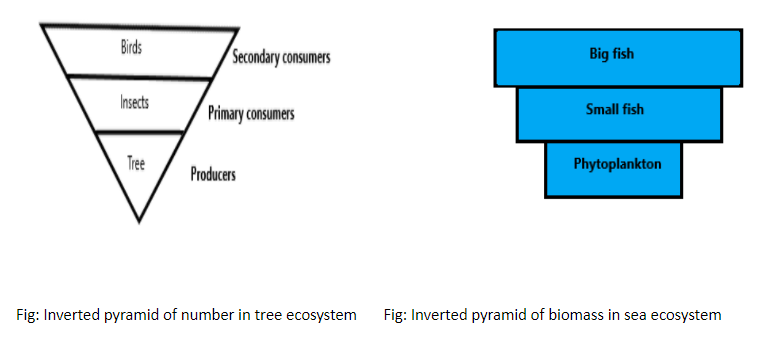
An inverted pyramid of number and an inverted pyramid of biomass are respectively seen in
A. Grassland ecosystem
B. Sea and tree ecosystem
C. Tree and sea ecosystem
D. Sea and grass ecosystem
E. Tree and grassland ecosystem
Answer
573.6k+ views
Hint: In a pyramid of number, the total number of organisms at each trophic level is taken into account. In a biomass pyramid, the organic matter present at different trophic levels in an ecosystem is represented.
Complete answer:
An ecological pyramid is a visual depiction of the relationship between various species in the environment. The relationship is expressed in terms of number, biomass or energy. The producers represent the base of each pyramid while the top represents the tertiary or top-level consumer. The common ecological pyramids are the pyramid of numbers, the pyramid of biomass and the pyramid of energy.
The number pyramid indicates the cumulative number of individual species at each stage of the food chain of the ecosystem. An inverted pyramid of numbers can be seen in an ecosystem where the population includes a few very big biomass suppliers that benefit a greater number of smaller consumers. Thus, the number pyramid in the tree ecosystem will be inverted as the first trophic level, that is, the tree, is the least in number in the ecosystem.

The biomass pyramid reflects the overall living biomass or organic matter found at various trophic levels in the ecosystem.The biomass pyramid in the sea is therefore usually inverted since the population of fish at the higher level much exceeds that of phytoplankton.
Thus, the correct answer is option C i.e., C. Tree and sea ecosystem.
Note:In most ecosystems, all pyramids of number, energy and biomass are upright. This means that the organisms at the lower level are greater in number and biomass than those at the higher levels. The energy at a lower trophic level is also usually greater than those at a higher level.
Complete answer:
An ecological pyramid is a visual depiction of the relationship between various species in the environment. The relationship is expressed in terms of number, biomass or energy. The producers represent the base of each pyramid while the top represents the tertiary or top-level consumer. The common ecological pyramids are the pyramid of numbers, the pyramid of biomass and the pyramid of energy.
The number pyramid indicates the cumulative number of individual species at each stage of the food chain of the ecosystem. An inverted pyramid of numbers can be seen in an ecosystem where the population includes a few very big biomass suppliers that benefit a greater number of smaller consumers. Thus, the number pyramid in the tree ecosystem will be inverted as the first trophic level, that is, the tree, is the least in number in the ecosystem.

The biomass pyramid reflects the overall living biomass or organic matter found at various trophic levels in the ecosystem.The biomass pyramid in the sea is therefore usually inverted since the population of fish at the higher level much exceeds that of phytoplankton.
Thus, the correct answer is option C i.e., C. Tree and sea ecosystem.
Note:In most ecosystems, all pyramids of number, energy and biomass are upright. This means that the organisms at the lower level are greater in number and biomass than those at the higher levels. The energy at a lower trophic level is also usually greater than those at a higher level.
Recently Updated Pages
Two men on either side of the cliff 90m height observe class 10 maths CBSE

What happens to glucose which enters nephron along class 10 biology CBSE

Cutting of the Chinese melon means A The business and class 10 social science CBSE

Write a dialogue with at least ten utterances between class 10 english CBSE

Show an aquatic food chain using the following organisms class 10 biology CBSE

A circle is inscribed in an equilateral triangle and class 10 maths CBSE

Trending doubts
Why is there a time difference of about 5 hours between class 10 social science CBSE

Write a letter to the principal requesting him to grant class 10 english CBSE

What is the median of the first 10 natural numbers class 10 maths CBSE

The Equation xxx + 2 is Satisfied when x is Equal to Class 10 Maths

Which of the following does not have a fundamental class 10 physics CBSE

State and prove converse of BPT Basic Proportionality class 10 maths CBSE




